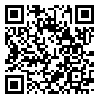Volume 15, Issue 3 (May & June 2025)
J Research Health 2025, 15(3): 283-292 |
Back to browse issues page
Download citation:
BibTeX | RIS | EndNote | Medlars | ProCite | Reference Manager | RefWorks
Send citation to:



BibTeX | RIS | EndNote | Medlars | ProCite | Reference Manager | RefWorks
Send citation to:
Armanmehr V, Asgharpourmasouleh A. Social Resilience and the COVID-19 Pandemic: The Case of a Suburban Residential Area in Light of Complexity Theory. J Research Health 2025; 15 (3) :283-292
URL: http://jrh.gmu.ac.ir/article-1-2534-en.html
URL: http://jrh.gmu.ac.ir/article-1-2534-en.html
1- Social Development & Health Promotion Research Center, Gonabad University of Medical Science, Gonabad, Iran.
2- Department of Social Sciences, Faculty of Letters and Humanities, Ferdowsi University of Mashhad, Mashhad, Iran. ,ahmadreza.asgharpour@gmail.com
2- Department of Social Sciences, Faculty of Letters and Humanities, Ferdowsi University of Mashhad, Mashhad, Iran. ,
Abstract: (2416 Views)
Background: COVID-19 has rapidly brought many changes to people’s lives. The current research aimed to explore how these changes affected the social resilience of the residents in a local neighborhood.
Methods: The present case study was conducted in the spring of 2021, using in-depth interviews and field observations in the Tawheed neighborhood of Gonabad City, Iran. Purposive sampling was used to select the interviewees with maximum variation. Interviews continued until data saturation was reached, which occurred after the 17th participant was interviewed. To analyze the data, a directed qualitative content analysis and the complexity approach proposed by David Byrne and Gil Callahan were utilized.
Results: The local residents’ social resilience during the pandemic was explained in light of the complexity theory. A total number of four categories and 13 sub-categories were extracted: uncertainty of the disease (uncertainty of information about the disease, no common understanding of the disease, no common norms of health behaviors, and unknown aspects of the disease), features of connectivity and network of social relationships (perceived common benefits, family cohesion, access to online social networks), initial states and availability of sources (unstable living conditions, poor health facilities, and structure of the neighborhood), interaction of micro- and macro-factors (trust in healthcare systems and leaders, and financial rules and policies).
Conclusion: The social resilience of the residents in the local neighborhood during the pandemic was influenced by many factors, primarily related to their initial conditions. To improve social resilience, it seems necessary to carry out effective interventions based on local and indigenous capacities.
Methods: The present case study was conducted in the spring of 2021, using in-depth interviews and field observations in the Tawheed neighborhood of Gonabad City, Iran. Purposive sampling was used to select the interviewees with maximum variation. Interviews continued until data saturation was reached, which occurred after the 17th participant was interviewed. To analyze the data, a directed qualitative content analysis and the complexity approach proposed by David Byrne and Gil Callahan were utilized.
Results: The local residents’ social resilience during the pandemic was explained in light of the complexity theory. A total number of four categories and 13 sub-categories were extracted: uncertainty of the disease (uncertainty of information about the disease, no common understanding of the disease, no common norms of health behaviors, and unknown aspects of the disease), features of connectivity and network of social relationships (perceived common benefits, family cohesion, access to online social networks), initial states and availability of sources (unstable living conditions, poor health facilities, and structure of the neighborhood), interaction of micro- and macro-factors (trust in healthcare systems and leaders, and financial rules and policies).
Conclusion: The social resilience of the residents in the local neighborhood during the pandemic was influenced by many factors, primarily related to their initial conditions. To improve social resilience, it seems necessary to carry out effective interventions based on local and indigenous capacities.
Type of Study: Orginal Article |
Subject:
● Health Systems
Received: 2024/04/17 | Accepted: 2024/07/13 | Published: 2025/05/30
Received: 2024/04/17 | Accepted: 2024/07/13 | Published: 2025/05/30
| Rights and permissions | |
 |
This work is licensed under a Creative Commons Attribution-NonCommercial 4.0 International License. |









